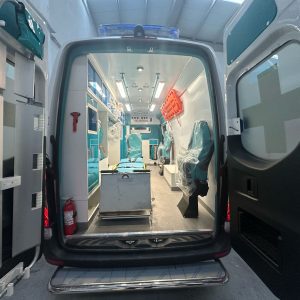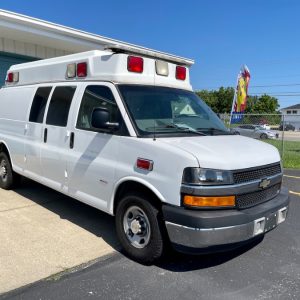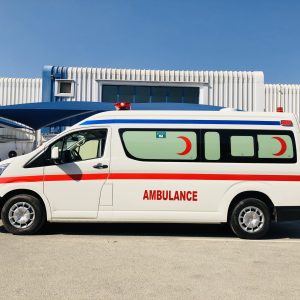Mobile hospitals, sometimes called mobile medical units or mobile health clinics, are healthcare facilities housed within customized trucks, vans, trailers, or other vehicles. Unlike traditional fixed hospitals, mobile hospitals can transport medical equipment and staff to provide healthcare services directly to patients.
Mobile hospitals have some key differences from regular hospitals:
- Transportable – They can drive to wherever they’re needed, rather than patients coming to them. This expands access to healthcare.
- Flexible – Their services can be tailored to specific communities and situations. A mobile hospital for rural towns may look quite different from one serving urban homeless populations.
- Scalable – Mobile hospitals can deploy as many or as few vehicles and staff as needed. This makes them adaptable.
- Streamlined – They provide targeted healthcare services efficiently, without operating a full-scale hospital facility.
Some pros of mobile hospitals include increased healthcare access, cost savings, and the ability to rapidly respond to medical emergencies and disasters.
Potential cons are limited services compared to traditional hospitals, less robust facilities/equipment, and fewer medical specialists on staff. But mobile hospitals excel at providing essential primary, preventive, and emergency care conveniently and affordably.
History of Mobile Hospitals
Mobile hospitals have been utilized for over a century to provide medical care in remote areas and disaster response situations. Some of the earliest uses of mobile hospitals date back to the late 1800s, when horse-drawn carriages were outfitted with medical equipment and sent to provide care to rural communities in the American West.
During World War I, trucks and trains were converted into mobile hospitals to provide urgent medical care to soldiers near battlefields in Europe. This allowed doctors to perform life-saving operations closer to the front lines. Throughout the 20th century, mobile hospitals advanced alongside vehicle technology and were deployed in military operations across the world.
In the civilian world, mobile hospitals began to be used in the 1950s and 1960s by public health organizations to bring medical services to rural towns and neighborhoods lacking health infrastructure. Early mobile hospitals focused on preventative care like vaccines, screenings, and health education.
Today, mobile hospitals utilize the latest developments in medical technology and transportation methods. Modern mobile hospitals are built into tractor trailers, buses, RVs, and even airplanes and helicopters. They contain state-of-the-art medical equipment like imaging machines, ICUs, and surgical suites to provide a wide range of acute care wherever it’s needed. With telemedicine capabilities, mobile hospitals can also connect patients and on-site staff to off-site medical experts for consultations.
How Mobile Hospitals Operate
They are essentially fully functioning hospitals that can be transported to different locations as needed. They feature many of the same services and facilities as traditional hospitals, just on a smaller, more portable scale.
Typical Features and Services
They usually contain an emergency room, operating room, imaging services like x-ray and ultrasound, a laboratory, and inpatient beds. They provide many of the same services you would find in a standard hospital ER and urgent care clinic, including:
- Emergency medical treatment for injuries and illnesses
- Stabilization and monitoring of critical patients
- Minor surgical procedures and wound care
- X-rays, CT scans, ultrasounds
- Laboratory testing and bloodwork
They have nurses, doctors, and other healthcare staff on site to diagnose, treat, and observe patients. Some mobile hospitals also offer telemedicine capabilities to consult remotely with specialists.
Medical Equipment Used
The medical equipment in mobile hospitals allows providers to assess, diagnose, treat, and monitor patients. Typical equipment includes:
- Patient stretchers and beds
- Ventilators and vital sign monitors
- Defibrillators and other emergency gear
- Surgical tools and anesthesia machines
- Imaging equipment like x-ray, ultrasound, and CT scanners
- Centrifuges, microscopes, and other lab equipment
- Medications, vaccines, IV fluids
The equipment is compact and secure to withstand transportation between sites.
Staffing
They have a team of medical staff on board, similar to a standard hospital ER. This usually includes:
- Emergency physicians
- Nurses
- Radiology techs
- Lab techs
- Administrative staff
- Security personnel
Some facilities also have specialists like surgeons or cardiologists available either on-site or via telemedicine. The staff are trained in emergency and urgent medical care.
Logistics of Transporting and Setting Up
Mobile hospitals are built into trucks, trailers, or semi-permanent structures that can be efficiently transported and set up. Most can be fully operational within a few hours.
Facilities built into truck trailers can be hitched to a truck and towed to locations. Semi-permanent structures are designed for quick assembly and disassembly. Some mobile hospitals use inflatable, temporary tents that provide flexible space.
They are equipped with generators, lighting, climate control, and other utilities to be self-sufficient medical facilities, regardless of the local infrastructure. Communication and satellite systems allow for connectivity. Proper protocols ensure sensitive equipment and materials are secured for transportation between sites.
With logistical coordination, mobile hospitals can effectively bring quality emergency care wherever it’s needed.
Benefits of Mobile Hospitals
Mobile hospitals provide several key advantages compared to traditional permanent healthcare facilities. Some of the main benefits include:
- Improved access to care – Mobile hospitals can extend medical services to underserved communities and remote areas. They provide care to populations that previously lacked access due to transportation barriers or distance from permanent facilities.
- Ability to rapidly respond to disasters/emergencies – Mobile hospitals can quickly deploy to disaster zones or areas impacted by emergencies. They allow medical personnel to provide on-site care when permanent facilities are damaged or overwhelmed.
- Lower cost than permanent facilities – Mobile facilities avoid the high construction and maintenance costs of permanent buildings and infrastructure. They offer a flexible, cost-effective way to provide healthcare, especially in resource-limited settings.
The mobility and adaptability of mobile hospitals allow them to fill gaps in the healthcare system. They can service temporary needs or rotate between locations as demands change. Mobile facilities bring quality medical care directly to the people who need it most.
Limitations of Mobile Hospitals
While mobile hospitals provide tremendous value, they also come with some limitations to be aware of:
Limited capacity – Mobile hospitals are designed to be compact and transportable, which limits the number of beds, equipment, and staff capacity. They cannot provide the same scale of care as a large traditional hospital. Capacity may range from just a couple beds to around 50 beds for the largest mobile hospitals.
Dependence on generators/fuel – Mobile hospitals rely heavily on backup generators and fuel supplies to power their facilities and equipment in remote areas without grid electricity. This dependence can make them vulnerable to fuel shortages or generator failures. Maintaining fuel supplies and equipment in rugged conditions presents logistical challenges as well.
Difficulty keeping staff – It can be challenging to find and retain qualified medical staff willing to work in the remote and austere environments where mobile hospitals are deployed. The work requires living in sparse camp conditions away from family. Staff burnout and turnover is a significant issue. Offering strong financial incentives, rotations, and quality of life measures helps retain staff.
Use Cases
Mobile hospitals provide vital medical care in situations where traditional hospitals are inaccessible or have been damaged. Some key use cases include:
- Providing care in rural/remote areas: Mobile hospitals can travel to isolated communities that lack adequate healthcare infrastructure. They bring services like general checkups, screening tests, minor procedures, and telemedicine closer to those in need. This improves outcomes and reduces the barriers of transportation, time, and cost.
- Responding to natural disasters: When disasters like floods, storms, or earthquakes damage hospital buildings, mobile hospitals can rapidly deploy on-site care. Their mobility and self-sufficiency allow them to assist immediately after a crisis when healthcare demand surges. They help bridge the gap until permanent facilities are repaired.
- Caring for displaced people/refugees: For refugee camps or groups displaced by war/conflict, mobile hospitals deliver necessary care. Given the temporary nature of camps, mobile facilities are ideal since they can shift locations as populations move. They provide basic services and prevent disease outbreaks.
- Military field hospitals: Mobile field hospitals have long served in war zones and remote deployments to care for armed forces personnel. Their portable design suits the mobile nature of military operations. They can be transported via planes, trucks, or ships and set up quickly where needed. Military mobile hospitals can provide frontline trauma care and emergency surgeries.
Mobile Hospital Design
They are designed for maximum portability and durability to serve patients in remote or disaster-struck areas. Typical layouts include expandable tents, inflatable structures, trucks, vans, buses, trailers, ships and even trains converted into medical facilities.
Inflatable mobile hospitals are quick to set up and can be expanded or contracted as needed. Made of durable PVC materials, inflatable wards provide climate control and isolation capabilities ideal for contagious disease outbreaks. These can be rapidly deployed by a small team who inflate the structure using fans and then outfit the interiors.
To withstand travel over rough terrain, mobile hospitals are built on durable truck, van and bus chassis or trailers. Interiors are customized based on the services offered, with modular components like examination rooms, operating theatres, imaging equipment, labs and pharmacies. The vehicle frame allows these facilities to be transported across land to remote locations.
Making them lightweight while maintaining sufficient space and equipment is an engineering challenge. The interiors maximize space utilization through compact, collapsible and multi-purpose furniture and equipment. The materials used must be able to withstand vibrations during transport. External features like satellite dishes, generators, water tanks and waste disposal systems must be secured. Overall the design focuses on being robust and portable.
Future Outlook
Mobile hospitals represent an innovative approach to healthcare that is still evolving. Here are some predictions for how mobile hospitals may grow and improve in the future:
- Expanded telemedicine capabilities: Mobile hospitals will likely incorporate more telemedicine technologies to connect patients and doctors remotely. This could include things like remote patient monitoring, video consultations, and access to specialists. Telemedicine allows mobile hospitals to leverage medical expertise wherever they are located.
- New medical technologies: As new medical devices and technologies emerge, mobile hospitals will be able to integrate them more rapidly than traditional hospitals. For example, mobile hospitals may be early adopters of portable diagnostic tests, AI-assisted imaging, and wearable patient monitoring devices. Their flexibility gives them an advantage in adopting cutting-edge medical tech.
- Customizable and scalable designs: Mobile hospitals will become more modular and customizable, allowing them to be tailored to specific medical needs and situations. Standardized shipping container designs will give way to more flexible hospital modules. Facilities will also be designed for rapid scaling up or down.
- Transition to electric and autonomous vehicles: To become more sustainable, mobile hospitals will likely transition from diesel vehicles to electric vehicles. Some may even adopt autonomous driving technologies to reduce labor costs and improve road safety. This will allow mobile hospitals to have a smaller environmental footprint.
- Growth in developing nations: Mobile hospitals have huge potential for bringing quality medical care to remote or underserved communities, especially in developing countries. Aid groups and NGOs may increasingly adopt mobile hospital solutions to reach vulnerable populations. This can help increase healthcare access and reduce health inequality.
The flexibility and cost-effectiveness of mobile hospitals means they are poised for strong growth in the future. They represent an innovative healthcare delivery model that can expand access, incorporate new technologies, and improve outcomes for patients.
Notable Mobile Hospitals
They come in many different forms and serve diverse purposes around the world. Here are some notable examples of innovative mobile hospital implementations:
Mercy Ships
Founded in 1978, Mercy Ships operates the world’s largest civilian hospital ship, the Africa Mercy. This converted rail ferry has 5 state-of-the-art operating rooms and provides free healthcare services to underserved communities along the coasts of Africa. Since its inception, Mercy Ships has treated over 2.8 million patients and performed over 100,000 surgeries.
Nepal Mobile Health Program
Run by the Nick Simons Foundation, this program deploys trucks equipped with medical equipment to provide primary care in remote mountain villages in Nepal. Each mobile health clinic is staffed by a doctor, nurses and a lab technician. They have treated over 50,000 patients since the program’s launch in 2016.
Emergency Mobile Hospitals
Various organizations have deployed rapidly deployable mobile hospitals to disaster zones and refugee camps, like the 2004 Indian Ocean tsunami. These field hospitals can be operational within 48 hours of arriving on site, providing lifesaving care with modular tents, generators, medical supplies and staff.
Floating Hospitals
Some mobile health clinics take advantage of a region’s waterways by using ships or barges equipped with medical facilities. These floating hospitals can access hard-to-reach populations residing deep inland along rivers and provide both preventative and acute care.
Airborne Hospitals
Customized aircraft like Boeing 747 jets have been converted into flying hospitals to transport and treat patients. They contain operating rooms, intensive care units and patient wards while in flight. The United States and various European countries have operated airborne hospital planes.
Key Takeaways
They play an important role in providing healthcare access to underserved communities and responding to disasters and emergencies. Though they have limitations in the services they can provide, They fill a vital healthcare gap.
The main points about mobile hospitals are:
- They are healthcare facilities built into trucks, trailers, or other vehicles. This allows them to transport medical equipment and staff to provide healthcare on-site.
- They have a long history dating back over 100 years. They have been used in wartime, by traveling doctors, and to serve rural areas.
- They can operate independently or collaborate with permanent hospitals. They go where the need is greatest, set up quickly, and can relocate as required.
- Benefits include serving remote communities, disaster response, medical outreach, expanded care capacity, and convenience. Limitations are smaller scale, equipment restrictions, and lack of permanent facilities.
- Use cases include rural clinics, vaccination programs, community health screenings, military sites, urban healthcare deserts, and emergency response. Custom designs accommodate different needs.
- Looking ahead, mobile hospitals will continue improving healthcare access, filling gaps, and responding rapidly. They demonstrate creative solutions to delivering vital medical services.
In summary, they are an innovative way to provide healthcare and meet communities’ needs. Their flexibility and mobility enable delivering quality care wherever it is required most. Though not a complete replacement for permanent hospitals, they are an important healthcare delivery model now and in the future.













